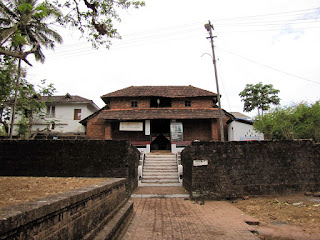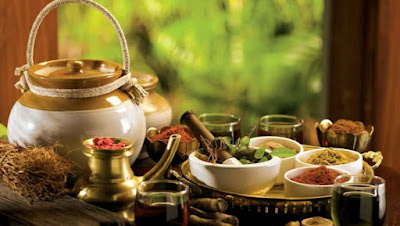Although, the Suchindram and famous Suchindram
Sthanumalaya Perumal Temple is located
in Tamil Nadu, it was a part of Kerala earlier. The area was under the rule of
Travancore Kings once and it has a significant place in the history of
Travancore. This temple is marked in history as the place where the test of
honesty has been conducted by the Kings. If someone comes under suspicion of
theft or any other criminal activity, the person will be brought to this
temple. Then a huge vessel will be placed in front of him filled with boiling
ghee. The suspect should dip his or her hands inside the hot ghee and if he or
she got burned, it is decided that the person is the culprit.
This practice has been followed for many years till Swathi
Thirunal abolished it. Actually, the harlequin of King’s court was behind such
a move. Once, some of the royal jewelry has missed and everybody pointed
fingers to the harlequin. He denied the allegation and told that he is ready to
take a test at Suchindram Temple. When all, including the King, was waiting
outside, the chief priest of the temple came out with a vessel full of hot
ghee. The priest was holding the vessel with a piece of cloth in order to
prevent his hands from the heat. Then the harlequin shouted firmly that it was
the priest who took the ornaments from the palace. He argued further that if it
was not the priest, why he should hold the vessel with a cloth. If he is
innocent, his hands will not get affected by the heat. Sensing the logic in
the argument, Swathi Thirunal, the King of Travancore stopped that barbarian practice.
This temple is only one temple in India, where the divine
powers of the trinity, Brahma, Vishnu, and Siva are presented in a single idol. And
it is believed that many great saints including Agasthya, Vyasa, Vasishta, etc
have visited this temple and worshiped the divine trinity. There are two
legends behind the origin of this temple.
In one of them, Saint Athri, along with his wife Anasuya
went to the Himalayas and underwent severe penance. Pleased with their devotion,
Lord Vishnu appeared in front of them and asked them to go towards the south and to
get settled near the Pranja Theertham in Gyanaranyam. He advised them to lead a
family living there. According to his instruction, both of them went to
Gyanaranyam (It was the old name for Suchindram) and started living there.
Once, Saint Athri had to go to Brahma Loka to participate in a Yagna. At that
time the holy trinities, Brahma, Vishnu, and Shiva decided to test Anasuya. They
appeared in front of her in the disguise of old Brahmins and requested her to give
them alms. When she turned inside to bring something, they insisted that she
should serve them food without wearing any clothes. They also told her that if
she is not ready to do it, they will not accept the alms and will go back.
She was an intelligent lady. She went inside and took a few
drops of holy water kept by Saint Athri for some rituals and sprayed it on the
old men after murmuring some holy hymns. Suddenly they all turned to be small
kids. Then she fed them milk and food without wearing any clothes. At the same
time, Saraswathi, Lakshmi, and Parvathy, the wives of Brahma, Vishnu, and Siva
respectively, came to know about the fate of their husbands. They came to
Gyanaranya and narrated the whole thing to Athri and requested her to save their husbands.
She expressed her inability and asked them to wait until Athri came back from
Brahma Loka. Three Goddesses spent the whole time in meditation near the Pranja
Theertham till Athri came back. The present-day festival in the Tamil Month
Markazi (November-December) is being celebrated to commemorate the meditation
of goddesses. When Atari came back, he came to know everything. He asked his
wife to bring a few more drops of holy water and spray over the kids. When she
did that the holy trinities regained their original shape. Quite happy with the
incident, the trinities asked Saint and his wife to ask for some boons. They
asked them to be present at the premises all the time. Suddenly they created
three stone pillars and placed one above the other. Then the trinities told
them that the base one is Brahma, the middle one is Vishnu and the top one is
Shiva. They assured the saint and his wife that their divine power will be in
this pillar shaped idol in the above-said order and asked them to worship it
regularly. Even now, the same idol is being used here.
The second legend is connected with Indra, the king of
demigods. Once, Indra was going through the skyways, he saw Ahalya, wife of
Saint Gowtham watering the plants in their compound. Attracted with her
physique and beauty, Indra started developing lust. He decided to enjoy the
beauty and youthfulness of Ahalya at any cost. Once he came to their Ashram
before the dawn and howled as if a cock. Saint Gowtham mistook it as that of an
original cock and thought the sun has risen. He went to have a bath in the river. Then Indram entered the Ashram in the disguise of Saint Gowtham and had sex with Ahalya. Gowtham realized that it
was still the night as soon as he reached on the banks of the river and hence
he returned. When he returned he saw both Indra and Ahalya in the compromising
position. He cursed Indra to have a penis all over his body as he did a sin due
to his uncontrollable lust. Similarly, he cursed his wife also to become a rock.
When pleaded, she got relief as the saint blessed her that Lord Sri Ram will
visit her during Threthayuga and will give her salvation.
Indra, who became an ugly figure with a penis all over the
body due to the curse, went to Gyanaranya and underwent penance there for
years. At the end of it, holy trinities appeared in front of him and removed
all the ugliness from his body. Thus Indra got purified. The place where Indra
got purified became popular as Suchindram (suchi means purification). On the
request of Indra, holy trinities transferred their divine powers to a single
stone and that is the idol being worshipped here even today.




















